
Twelve Great Emperors of Ancient India

A Gandhara Sculpture
India has a long history which dates back to the Indus Period (about 3000 BC), and may be earlier to preceding cultures, since an advanced civilization such as the Indus could not have appeared, without prior development. In its long history, India, which then comprised of the whole Indian subcontinent and adjoining territories, was ruled by many kings, queens and emperors. Some were legendary and some were historical. The principality of Magadha witnessed the emergence of the first great Indian empire about 600 BC, through conquests and annexations first by the rulers of the Haryanka dynasty and later by the Nandas. They were followed by the Mauryan dynasty. They pioneered vast empires, built large and powerful armies and established well-organized administrative systems.
In its long history, the land witnessed the rise and fall of numerous dynasties, kings and emperors, each comparable to any in the West. However, it was never entirely under the control of a single emperor. We present here twelve great rulers of ancient India who played an important role in shaping its history and civilization. It is well known that history mostly remembers victors, whether they are good or evil, and records their version of events. In its long history, India saw the rise and fall of numerous dynasties and thousands of kings and queens. Most of them are not at all remembered, but their contribution cannot be ignored in the march of the civilization. By recognizing these 12 rulers, we do no intend to undermine the rest of the kings and queens who were a part of its known and unknown history..
(Ps: The dates for these rules are taken from history text books. Due to lack of historical records,there is no unanimity among historians about the exact period of their reign.)
1. Ajatashatru (551 BC - 519 BC)
Bimbisara, was the first emperor to annexe many small states (Mahajanapadas) and independent republics and lay the foundation of a mighty Magadhan empire which included 80,000 villages and several republics. His son Ajatashatru, also known as Kunika, continued his father’s policy of conquests and extended it further, often using dubious means to defeat his rivals such as the Licchaivies of Vaisali. According to some Buddhist texts, he succeed to the throne by imprisoning his own father and killing him. His religious affiliation is not clear. Both Jain and Buddhist texts claim him to be a follower of their respective faiths, since he patronized and admired both Mahavira and the Buddha after personally meeting them. Archeological and literary evidence, however, suggests that he might have converted to Buddhism in the last phase of his life and died as a Buddhist. The first Buddhist council was probably held under his leadership. Ajatashatru also figures in the Upanishads as a learned king who was well-versed in the secret knowledge of the self. However, we do not know whether it is the same historical king or a different person.
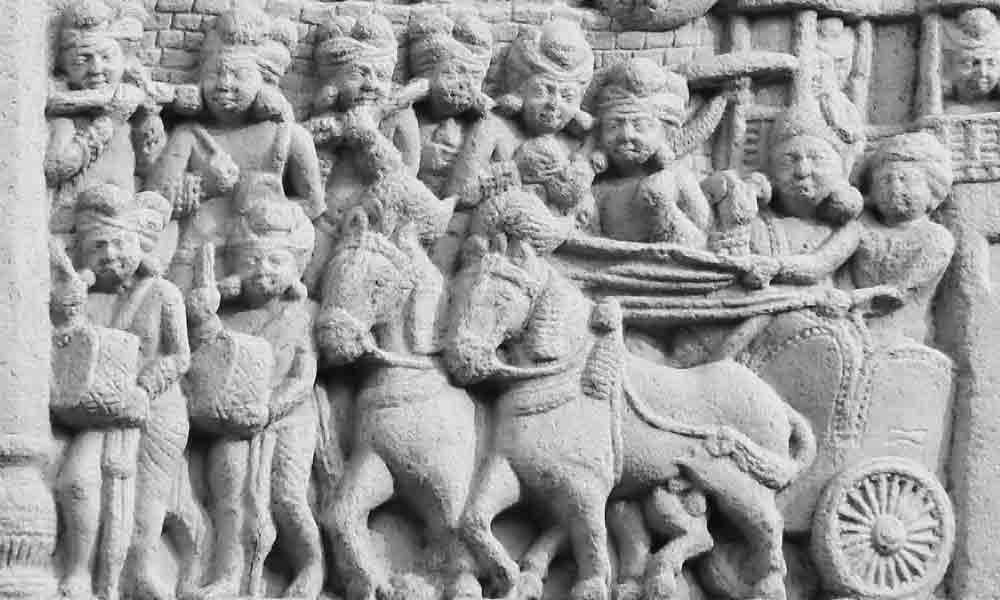 Royal procession leaving Rajagriha, possibly depicting Ajatashatru, from Sanchi, CC BY-SA 3.0
Royal procession leaving Rajagriha, possibly depicting Ajatashatru, from Sanchi, CC BY-SA 3.0
2. Chandragupta Maurya (Approx. 321 BC -298 BC)
Most historians agree that the first true emperor of India was Chandragupta Maurya. He ascended the throne between 323 BC and 321 BC, after defeating Dhana Nanda in a fierce battle. His birth and early childhood are unclear. He probably belonged to some royal lineage through his mother but grew up in relative obscurity with a strong desire to become a sovereign in his own right. According to legends he organized a rebellion against the Nandas with the help of a shrewd teacher and advisor named Chanakya and succeeded in overthrowing them. According to Greek texts, during this period he met Alexander who was then stationed in North West India as a part of his world conquest. In his short career of 20-25 years, Chandragupta fought and won many battles against the native kings and the Greek Satraps of Alexander and established a large empire which extended from the borders of Iran in the North to the Bengal region in the east and the Deccan plateau in the South. He also established an efficient and highly organized central and provincial administrative system, consisting of numerous departments headed by ministers and state officials, each entrusted with specific duties. According to Megasthanese, the Greek ambassador to his court, he had a huge army of 60,000 infantry, 30,000 horsemen, 3000 chariots and 9000 elephants. He also kept an eye upon his internal and external enemies through an efficient spy system.
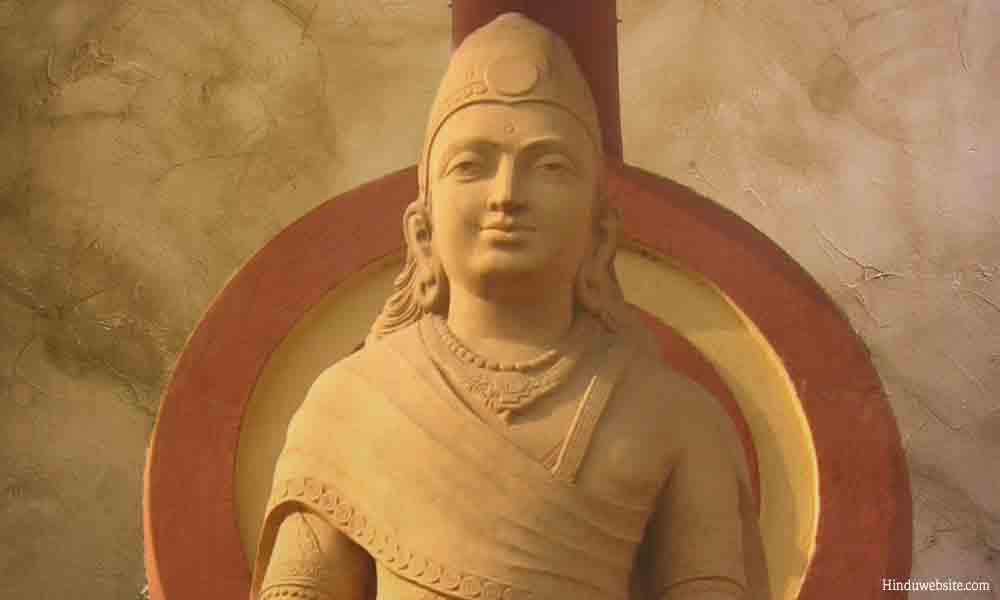 An artistic impression of Chandragupta Maurya, a statue at Birla Mandir
An artistic impression of Chandragupta Maurya, a statue at Birla Mandir
3. Ashoka (273 BC -239 BC)
Ashoka was the son of Bindusara and grandson of Chandragupta Maurya. His early life was marred by extreme cruelty, violence and war of succession in which he said to have killed many brothers, which according to some was probably rather exaggerated. However, in his early life he was a ruthless ruler, and by no means peace loving or benevolent. Ashokanandana, a Buddhist text, states that he persecuted and killed thousands of Ajivikas for the simple fault of showing Buddha as bowing to Gosala, their teacher, in a painting. Before his conversion to Buddhism, Ashoka waged many wars and conquered almost the whole subcontinent. He was probably the only emperor in the history of India to achieve such a distinction. After the Kalinga war, which resulted in huge bloodshed on both sides, he had a change of heart and became a pacifist and a humanitarian. Although he converted to Buddhism, he promulgated his own law of piety (Dhamma), containing the best of all the Dharmas, which he spread throughout his empire by inscribing it on several rock edits and appointing ministers of Dharma to propagate it. He was also responsible for the early propagation of Buddhism in India and outside, and codifying Buddhist texts by organizing two Buddhist councils. He also undertook several welfare measures such as building roads and rest houses, digging wells, planting trees, etc.
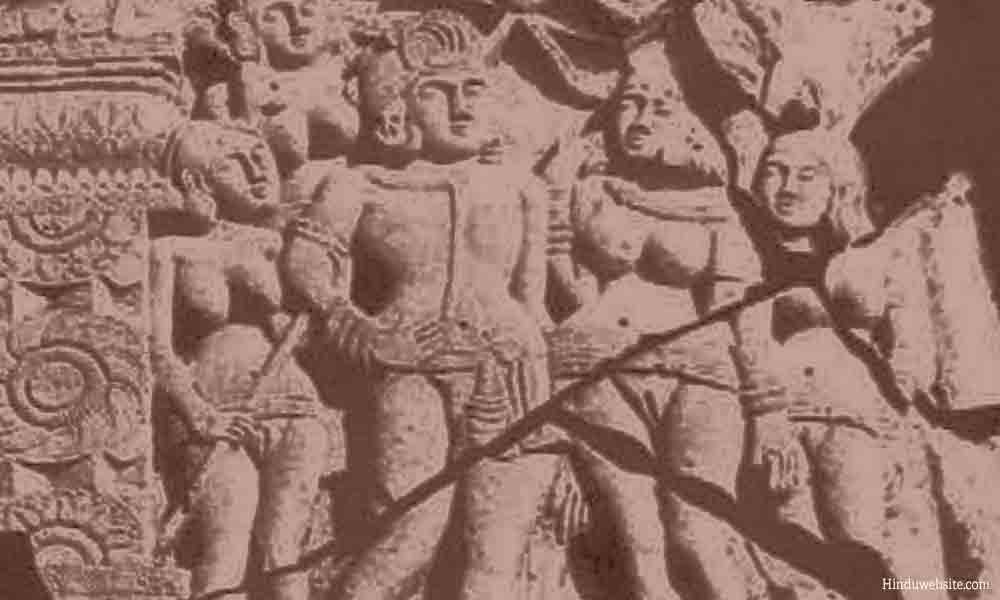 Kanaganahalli inscribed panel portraying Asoka, 1st-3rd AD
Kanaganahalli inscribed panel portraying Asoka, 1st-3rd AD
4. Gautamiputra Satakarni (70 AD – 95 AD)
The Satavahanas were probably the first Brahminical Hindu kings to rule central and southern India, approximately from 200 BC to 250 AD. They revived the Vedic Dharma at a time when it was in decline and India was mostly ruled by Buddhist and Jain rulers. Amaravathi or Dhanyakataka was their capital for a long time. Of the several great kings of the dynasty, Gautamiputra Satakarni (named after his mother Gautami) was the most prominent. The inscriptions of his time, including the famous Nasik inscription, describe him as a great warrior and the lord of the Vindhyas, who defeated Sakas, Yavanas and Pahlavas, including the famous Saka chief Nahapana and extended his empire from Krishna in the South to Malwa and Kathiawar in the North, and from Berar in the East to Konkan in the West. He undertook several measures to reestablish the Vedic Dharma and restore several ancient practices including the horse sacrifice. On the economic front, since his empire extended to the sea coasts on both sides, he improved trade with foreign countries across the Arabian sea and Bay of Bengal. He was also benevolent ruler, who showed tolerance towards both Buddhism and Jainism and allowed them to flourish along with his own. As a result, many Buddhist monuments, caves and learning centers sprung up in different parts of his empire, some of which survived until now.
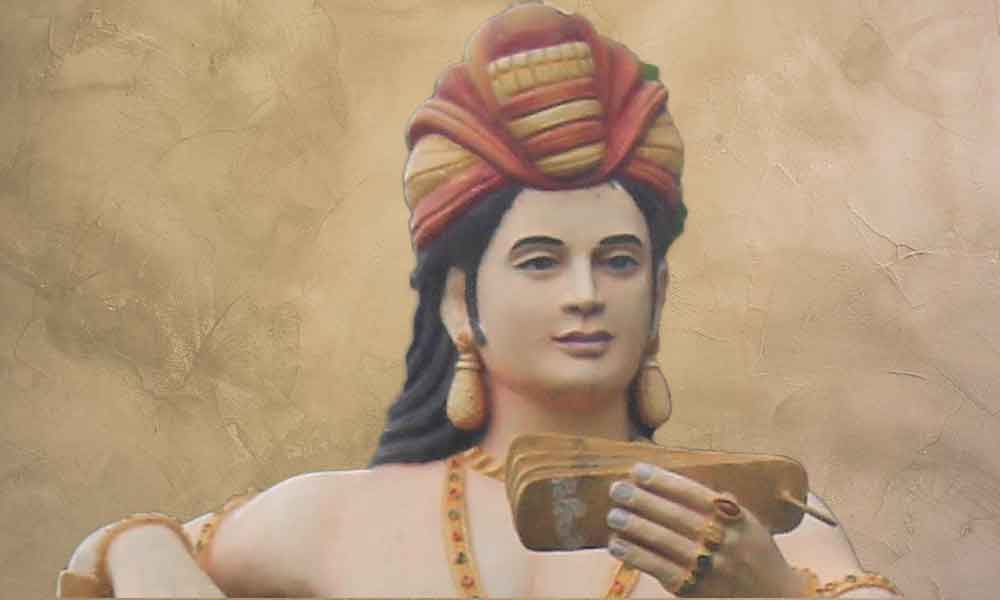 An artistic impression of Gautami Putra Satkarni, a Statue at Amaravathi © BY-SA 4.0
An artistic impression of Gautami Putra Satkarni, a Statue at Amaravathi © BY-SA 4.0
5. Kanishka (Approx. 78 AD – 101 AD)
Kanishka was the greatest of the Kushana rulers, who originally belonged to an ancient, Chinese tribe of nomadic origin, who settled in central Asia and gradually moved into northern India through conquests. He was a great warrior and conqueror, who established a large empire through many conquests. His empire covered a greater portion of north India and northwest frontier, as far as Magadha in the East, Vindhyas in the South and central Asia in the North. With Purushapura (Peshawar) as his capital, he established a provincial form of government, known as kshatrapi (or satrapy) system and ensured a reign of peace. Kanishka was also a prolific builder who built many religious and secular structures and monuments. His coins suggest that probably he adapted Greek as his official language. Although in his early life he worshipped many Indian, Iranian and Greek gods, which was probably a continuation of his ancestral faith, later he converted to Buddhism and just as Ashoka undertook several measures to propagate it. Apart from building several stupas and chaityas and sending missionaries to foreign countries, he organized the Fourth Buddhist council to settle doctrinal matters and divergent opinions and practices. He also patronized art and learning. His court was adorned by famous poets and philosophers such as Asvaghosha, Nagarjuna and Vasumitra. The Gandhara style of sculpture, with its distinct Indo-Greek features, flourished in his reign.
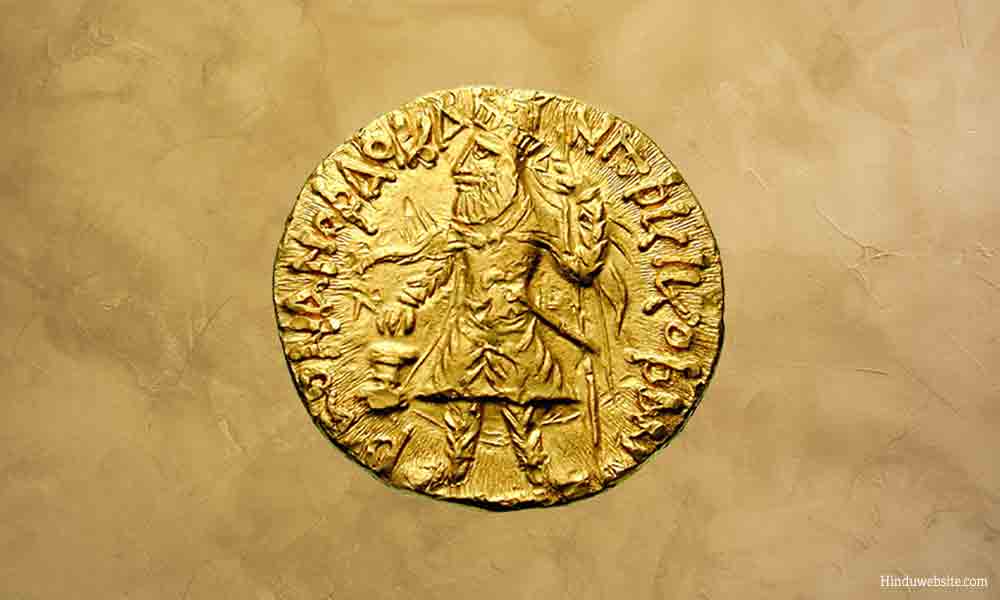 Standing Kanishka on a gold coin (120 AD) © BY-SA 3.0
Standing Kanishka on a gold coin (120 AD) © BY-SA 3.0
6. Rudradaman (130 AD – 150 AD)
The Sakas were Scythians, who established their sway in various parts of India, taking advantage of the power vacuum which was created by the decline of the Mauryan empire and weakening of native kingdoms. In the Sanskrit literature, the Scythians were known as barbarians, along with Parthians and Indo-Bactrians. They established the Kshatrapi form of government in which a sovereign ruler (Mahakstrapa), assisted by one or more deputies (kshatrapas), managed the affairs of the government. The most powerful among them was Rudradaman, the Mahakshatrapa of Ujjain. The Junagadh rock edict provides some information about him. According to it, Rudradamana revived the falling fortunes of his family by defeating Gautamiputra Satakarni twice and eventually ended their rivalry on a good note by marrying his daughter to him and making him as his ally. His empire covered a large part of Western Madhya Pradesh, Gujarat and Saurashtra. Besides being a warrior and learned king, Rudradaman was also a benevolent ruler, who is credited with the construction of a dam on the Sudarshan lake at his own expense, without collecting additional taxes from people. It is also said that he took an oath not to kill anyone except in a war, a promise which he kept until the end.
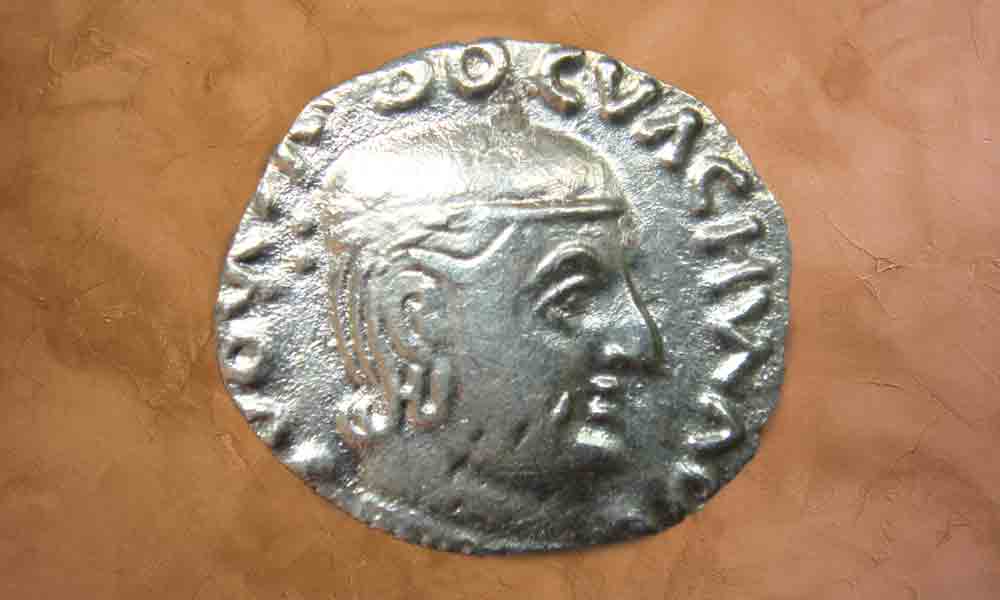 Silver coin showing the bust of Rudradāman, with a corrupted Greek legend, © BY-SA 3.0
Silver coin showing the bust of Rudradāman, with a corrupted Greek legend, © BY-SA 3.0
7. Samudra Gupta (335 AD – 375 AD)
Samudra Gupta is famous for the numerous battles he fought and won, and the large empire he created, using force, wars, tact and diplomacy. Details of his exploits are known to us mainly from the Allahabad pillar inscription, which suggests that upon ascending the throne, he wanted to be the lord of the seas and conquer the world. His first long campaign was in southern India (dakshinapath), against the kingdoms south of the Vindhyas, in which he defeated about 11 kings and forced them to pay taxes and accept his sovereignty. In his next campaign, he exterminated several kings in the North and annexed their territories. His third campaign was against the tribal rulers of central India. According to the inscription, he reduced them to the status of servants. In his fourth campaign, he forced the rulers of frontier states and several independent republics to submit to his rule and pay taxes. Through these conquests, agreements and diplomatic maneuvers, he ruled over a large empire, which consisted of the whole of northern India up to the Himalayas in the north and the Krishna River in the South. Besides being a great warrior king, Samudra Gupta was also a great administrator, philanthropist, lover of arts. Although he practiced Hindu Dharma and worshipped Hindu gods, he was tolerant towards other faiths.
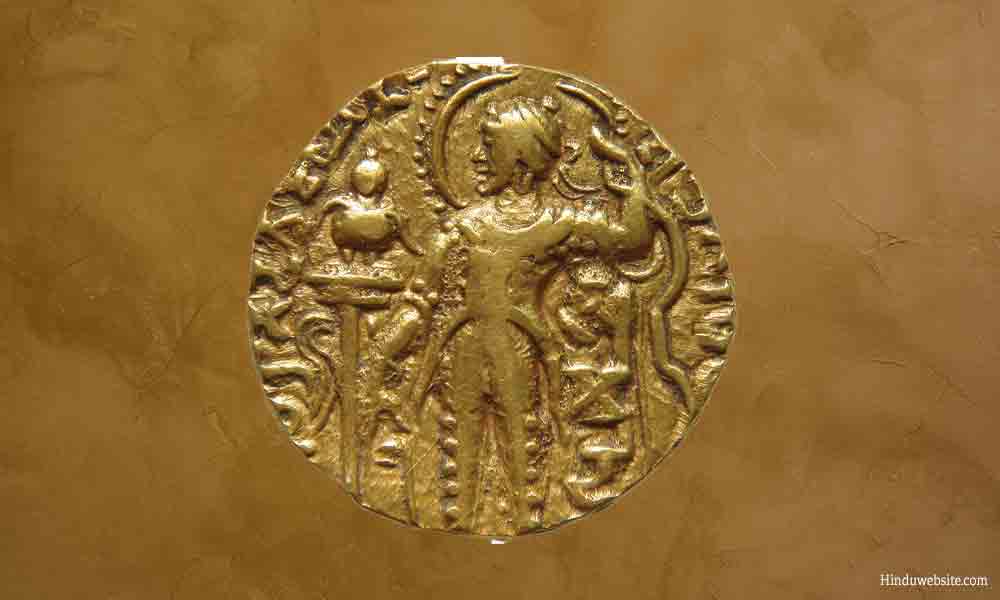 Gold coin depicting Samudragupta in warrior attire, © BY-SA 3.0
Gold coin depicting Samudragupta in warrior attire, © BY-SA 3.0
8. Chandra Gupta II (375 AD – 414 AD)
Chandragupta the Second was the son of Samudra Gupta. He was not chosen by his father as his successor, but was forced by circumstances to become an emperor and restore the falling fortunes of his dynasty, when his elder brother, Ram Gupta failed to hold the empire. Due to his valor and sagacity, he earned the title of Vikramaditya, the legendary king, who is mentioned in several folk traditions and literary works for his skill in passing wise judgments. Like his father, Chandra Gupta was a great warrior. He consolidated his power through conquests, diplomacy and matrimonial alliances. He is credited with the conquest and annexation of Bengal, and several territories in the East and west which were ruled by Sakas and several native rulers, thereby extending his empire to almost the whole of India. His reign saw the renaissance of Hindu culture, art, astronomy, science and literature. The famous poet and playwright Kalidasa was one of the nine gems who adorned his court. The Chinese traveler, Fahien, visited India during his reign and gave a firsthand description of the glorious conditions which he witnessed. The Gupta kings practiced Vedic Dharma. They built many temples in honor of Hindu gods such as Vishnu and Shiva and revived several ancient practices. At the same time, they showed tolerance towards Buddhism and Jainism and allowed them to flourish. The Gupta period is known in Indian history as a golden age (swarna-yug).
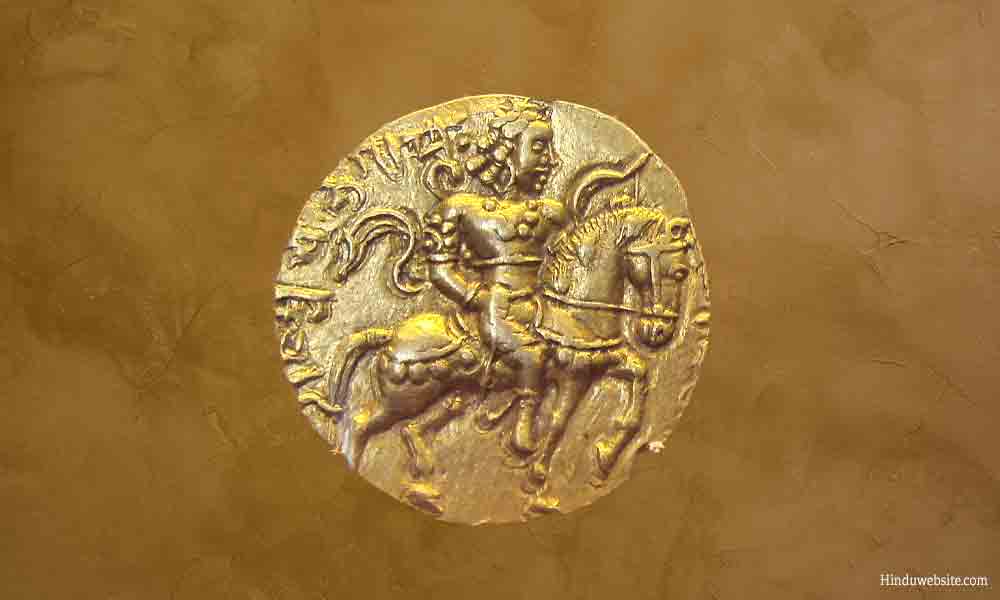 Gold coin depicting Chandragupta Second, © BY-SA 3.0
Gold coin depicting Chandragupta Second, © BY-SA 3.0
9. Harshavardhana (606 AD – 647 AD)
Harshavardhana was a unique emperor in the history of India, who can best be described as a warrior, scholar, monk and monarch who combined in himself the best of sovereignty, literary brilliance, religiosity, virtuosity, character, leadership and monkhood. A lot of information about his reign is available to us due to the accounts left by Chinese travelers and literary works such as Bana’s Harshacharita. Although he had an exemplary character, Harshavardhana was not a pacifist by any measure. He waged many wars and annexed several kingdoms. At the same time, he showed compassion and generosity by literally emptying his treasury once in every five years and giving away all his wealth and personal possessions to his subjects. He was also pragmatic enough to recognize the strength of his opponents and set aside his pride to make peace with them, as he did in case of Pulakesin II who defeated him and forced him to accept peace terms. Harshavardhana practiced a composite faith, consisting of both Hindu and Buddhist elements. He erected temples in honor of Surya, Shiva and Buddha and paid them homage. However, it seems that in the later part of his life he followed Mahayana Buddhism. He also organized two Buddhist assemblies at Kaanuj and Prayaga to promote Mahayana Buddhism. The famous learning center at Nalanda flourished during his reign.
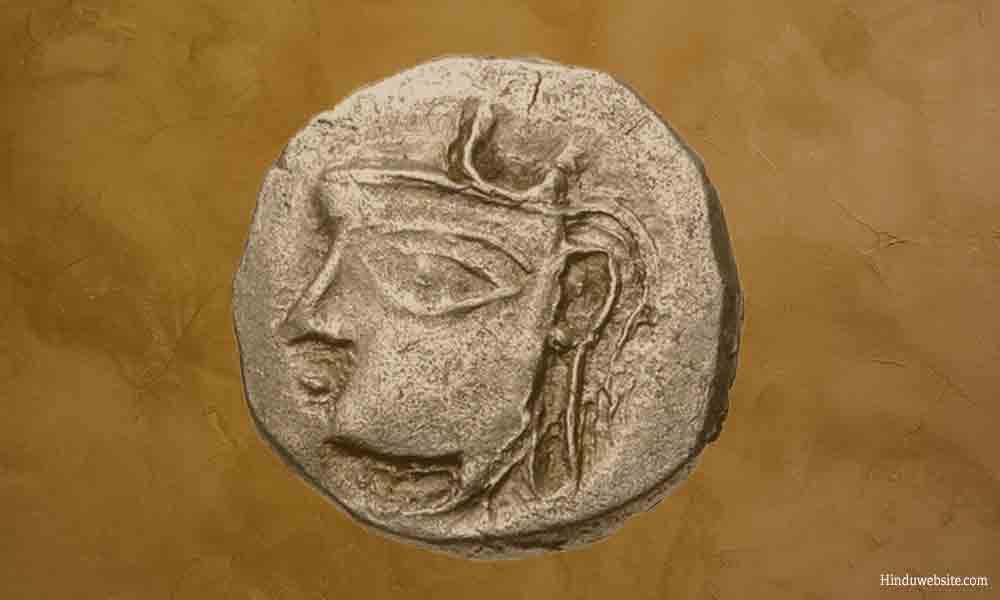 Gold coin depicting Harshavardhana with a crescent, © BY-SA 3.0
Gold coin depicting Harshavardhana with a crescent, © BY-SA 3.0
10. Pulakesi II (610 AD - 642 AD)
Pulakesi the Second was the most powerful king of the Western Chalukyan dynasty of Badami. He is hailed in the inscriptions as Vallabha, Prithvi Vallabha, Parameswara-Parama-Bhagavata, etc. They denote his Vaishnava faith and religious proclivity. The Chinese scholar, Hieun Tsang who travelled through his empire described the social and economic conditions of the people, their manners and customs, during his reign. Pulakesi II ascended the throne at a difficult time, but by his valor and statesmanship saved his empire from internal strife as well as external threats. The Aihole inscription by Ravikriti, a Jain monk, provides a detailed account of his achievements, according to which he waged several wars and established a large empire. It states that he marched northwards to defeat the Kadambas and occupy Varanasi. Later, he formed an alliance with them and forced a few kingdoms in the South into submission. He also defeated the Mauryas of Konkan, the Latas, Malvas and Gurjars in central India. Making Shasank as his ally, he waged a war against Harshavardhana about 630 AD and defeated him. He also defeated the Pallava king Mahendravarman and conquered a part of his kingdom. According to Tabari, a Muslim historian, Pulakesi sent an ambassador to Persia. One of the painting at Ajanta said to contain a scene showing him receiving an ambassador from Persia. However, this theory is disputed.
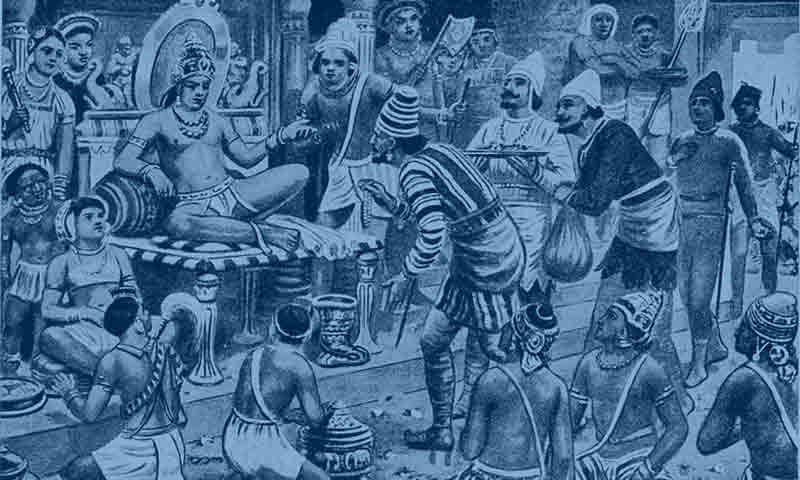 Artistic depiction of Pulakeshin receiving envoys from Persia.
Artistic depiction of Pulakeshin receiving envoys from Persia.
11. Rajaraja Chola (985 AD – 1014 AD)
The Chola dynasty was one of the most ancient dynasties of India. References to them are found in the Mahabharata, Mahavamsa, Sangam literature, the Indika of Megashanese and the inscriptions of Ashoka. They had a long history with fluctuating fortunes. Their power reached its zenith in the 10th and 11Th century AD under Rajaraja Chola, also known as Rajaraja, the Great, whose military exploits are mentioned in detail in the Tanjore inscription. According to it, he fought battles against the Cheras, whose navy he destroyed, the Pandyas of Ceylon, whose kingdom he annexed, and the Western Chalukyas, whose territory he invaded and subjected them to great humiliation. He also waged wars and annexed Vengi (Andhra Pradesh), Kalinga (Odisha) and the islands of Maldives. His empire covered large portions of south eastern India. Rajaraja Chola was an efficient administrator and a great builder. He introduced many administrative reforms and initiated accurate land survey for improving and systemizing revenue collection. Many Shiva and Vishnu temples were built during his reign including the famous Rajarajeswara Temple at Tanjore, which is a marvel in stone, with its central tower (shikhara) rising to 190 feet, crowned by a massive 25 feet tall dome, made of a single stone. He established a large naval fleet and fought many battles in the sea.
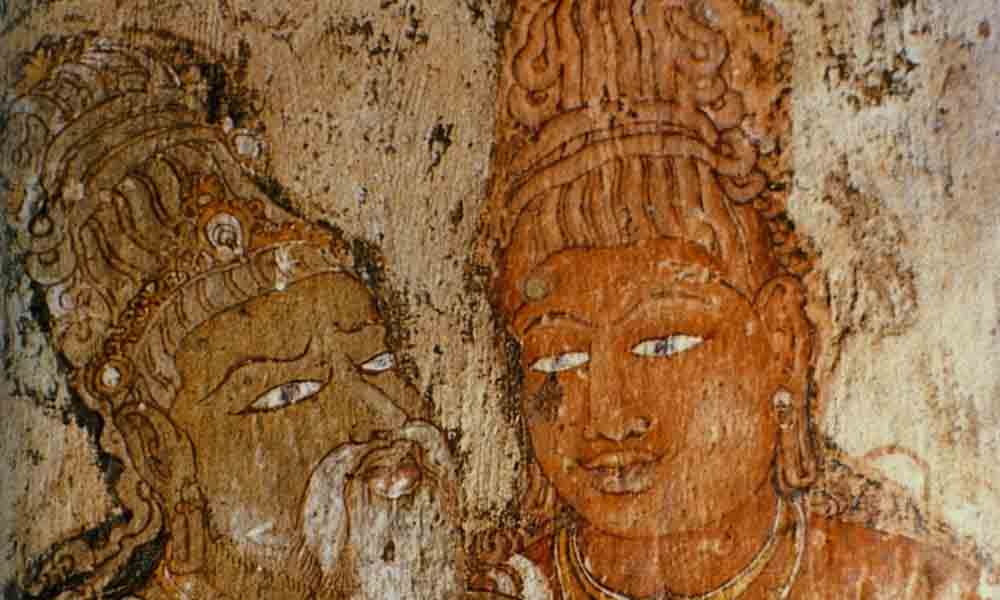 Mural depicting Rajaraja and his guru Karuvuruvar found in the Brihadisvara temple, 11th century.
Mural depicting Rajaraja and his guru Karuvuruvar found in the Brihadisvara temple, 11th century.
12. Rajendra Chola 1
Rajaraja Chola was succeeded by his son Rajendra Chola, also known as Gangaikonda Chola. He was an equally great king, who continued his father’s policy of conquests and annexations and extended the empire to Bengal. His conquest of Bengal eventually led to the foundation of the Sena dynasty there by his provincial governors. Rajendra Chola is also credited with conquests in the Far East. The inscriptions of his time state that he led expeditions across the high rolling seas and conquered Kadaram, defeating its king, Sangrama Vijayottungavarman. Apart from that, he also conquered the kingdoms of Sri Vijaya and Pannai in Sumatra, Mayirudingam, Illangosoka, Madamalingam, etc., in Malaya, and Manakkavaram in the Andaman and Nicobar Islands. However, it is not clear what the objective of those conquests was, and how effective they were. He probably went there to collect war spoils or open trade routes. Rajendra Chola founded a new capital at Gangaikonda Cholapuram, where he set up an irrigation system and built some temples and palaces. His other notable achievement was the opening of a Vedic learning center with 340 students and 14 teachers.
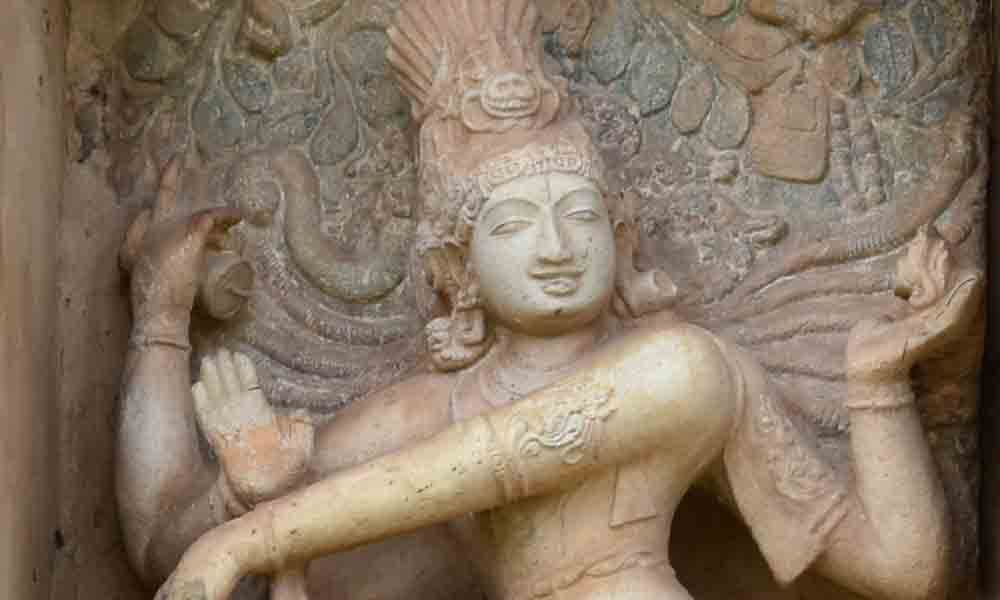 A sculpture of Nataraja on the Wall of Gangaikonda Cholapuram Temple, built by Rajendra 1, © BY 2.0
A sculpture of Nataraja on the Wall of Gangaikonda Cholapuram Temple, built by Rajendra 1, © BY 2.0
Thus, it can be seen that ancient India witnessed many great emperors over a span of 1500 years. They came from different backgrounds, established vast empires through conquests, and showed exemplary character and courage, mixing pragmatism with idealism and striking a balance between religiosity and imperial duties and between aggression and humanitarian considerations. Although they practiced different faiths, they were tolerant towards other faiths at times patronized them. They were exceptionally unique in the history of the world, and at times far ahead of their times. By patronizing art and literature, promoting religious harmony, enforcing the laws by invoking divine authority and following established norms and prevailing laws, and honoring its diversity and ancient traditions, they contributed to the growth of Indian civilization,
Suggestions for Further Reading
- The Symbolism of Snakes and Serpents in Hinduism
- Ten Distinguishing Features Of Hinduism
- Ten Reasons Why You Should Worship Shiva
- The River Sutra - Lessons From the River
- The Ten Main Duties (dharmas) in Hinduism
- The Ten Manifestations Of Sattva in Hinduism
- The 12 Manifestations of Brahman, the Supreme God of Hinduism
- Ten Teachings of the Buddha From the Dhammapada
- The Meaning And Significance Of Swastika In Hinduism
- What is Prana? The Five Types of Breath
- Hinduism and the God of Death
- Om, Aum, Pranava or Nada in Mantra and Yoga Traditions
- Wealth and Duty in Hinduism
- Hindu Gods - Lord Ganesha
- Symbolism and Significance of the Descent Of Ganga
- Symbolism of Ganga As the Purifier and Liberator
- The Meaning and Significance of Heart in Hinduism
- The Origin and Significance of the Epic Mahabharata
- Yin and Yang, and the Hindu Connection
- Symbolism in the Story of Sagar Manthan, the Churning of The Ocean
- The Symbolic Significance of Puja Or Worship In Hinduism
- Essays On Dharma
- Esoteric Mystic Hinduism
- Introduction to Hinduism
- Hindu Way of Life
- Essays On Karma
- Hindu Rites and Rituals
- The Origin of The Sanskrit Language
- Symbolism in Hinduism
- Essays on The Upanishads
- Concepts of Hinduism
- Essays on Atman
- Hindu Festivals
- Spiritual Practice
- Right Living
- Yoga of Sorrow
- Happiness
- Mental Health
- Concepts of Buddhism
- General Essays
Copyright and Image Credits: The images used in this article are licensed under various Creative Commons Attribution-Share Alike licenses. The content of the article is copyright Hinduwebsite.com and shall not be reproduced in any format or medium without prior written permission.